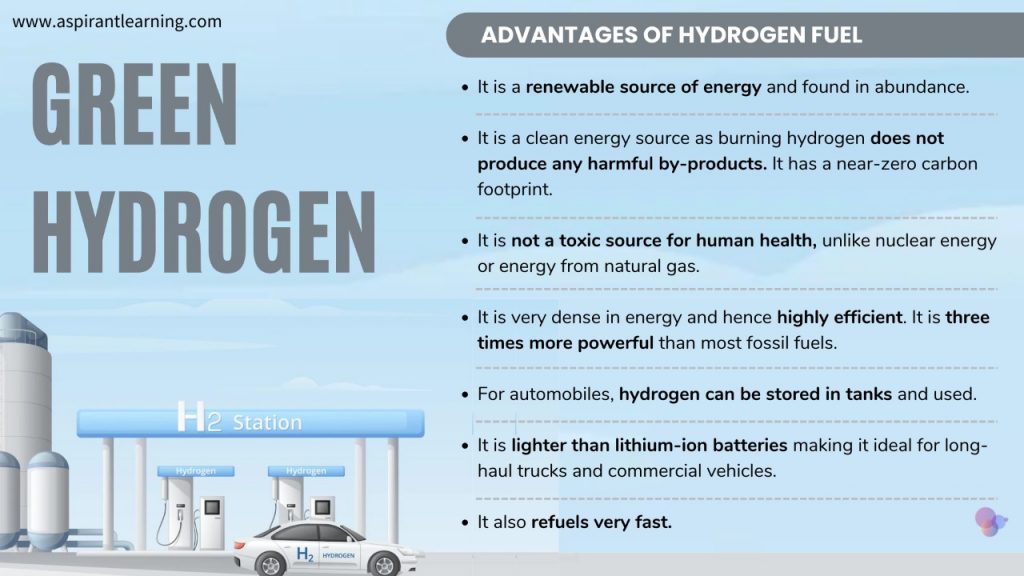News Highlight
Green Hydrogen Mission: Plan to make India energy-independent, and decarbonise significant sectors of the economy.
Key Takeaway
- The Union Cabinet on January 4 approved the National Green Hydrogen Mission, which is aimed at making India the global hub for the production of green hydrogen.
- The total outlay for the mission is ₹19,744 crore, out of which the government has allocated ₹17,490 crores for the Strategic Interventions for Green Hydrogen Transition (SIGHT) programme.
- ₹1,466 crore for the upcoming pilot projects, ₹400 crore for R&D, and ₹388 crore towards other mission components.
Green Hydrogen Mission
- About
- The government will create a timeline for utilising hydrogen as an energy source as part of the mission.
- The transportation industry could change as a result, along with other businesses.
- This expedition will take advantage of the fact that hydrogen is the most common element on Earth.
- Furthermore, the fuel is significantly cleaner.
- The emphasis of this expedition will be on hydrogen from clean sources.
- Additionally, it envisions integrating the hydrogen economy with the nation’s expanding capacity for renewable energy.
- India has a 175 GW renewable energy production goal for 2022, and this mission is anticipated to help with that goal.
- The goal for renewable energy is 450 GW by 2030.
- The country has set to decarbonise by 2050.
- The transportation, chemical, and steel industries are the final consumers of hydrogen energy.
- Due to their use of fossil fuels, these industries are responsible for 1/3 of all greenhouse gas emissions.
- In these industries, switching to hydrogen from fossil fuels will significantly reduce GHG emissions.
Need for the Mission
- India heavily depends on fossil fuels to generate electricity (coal).
- If hydrogen can take its place, pollution will be decreased (because of not burning fossil fuels).
- Additionally, coal imports may be decreased.
- The most prevalent element in the universe, hydrogen also offers the advantages of being lighter, more energy-dense, and more energy-efficient (2 – 3 times more than petrol).
- The transportation, iron, steel, and chemical industries will accrue benefits.
Benefits of the Mission
- Creation of export opportunities for Green Hydrogen and its derivatives.
- Decarbonisation of industrial, mobility and energy sectors.
- Reduction in dependence on imported fossil fuels and feedstock.
- Development of indigenous manufacturing capabilities.
- Creation of employment opportunities.
- Development of cutting-edge technologies.
Green Hydrogen
- About
- It is created by electrolyzing water to separate it into hydrogen and oxygen using a machine fueled by renewable energy sources like solar and wind.
- The fuel has the potential to fundamentally alter India’s energy security, as the country now imports 53% of its gas and 85% of its oil.
- India is considering requiring oil refineries and fertiliser factories to buy green hydrogen to boost sustainable fuels.
- Significance
- For India to achieve its Intended Nationally Determined Contribution (INDC) Targets and provide regional and governmental energy security, access, and availability.
- Future renewable energy intermittencies will require energy storage, which green hydrogen can provide.
- In terms of mobility, Green Hydrogen can be used in railways, massive ships, buses, or trucks for long-distance mobilisations for either urban freight movement within cities and states or for passengers.
- The primary renewable energy source for supporting infrastructure has the potential to be hydrogen.

Way Forward
- By utilising low-cost renewable power plants and the experience, it has garnered from cost-curtailment through solar and wind reverse auctions.
- India can lower the price of green hydrogen.
- Huge market potential, brought on by a young population and a booming economy.
- It will benefit the government in the long run while encouraging hydrogen-based technologies.
- As it has its limitations, hydrogen should be viewed as a supplement to its alternatives rather than as the only option.
- By 2030, it is anticipated that the current storage and transportation technologies will be mature and efficient.
Pic Courtesy: freepik
Content Source: The Hindu



